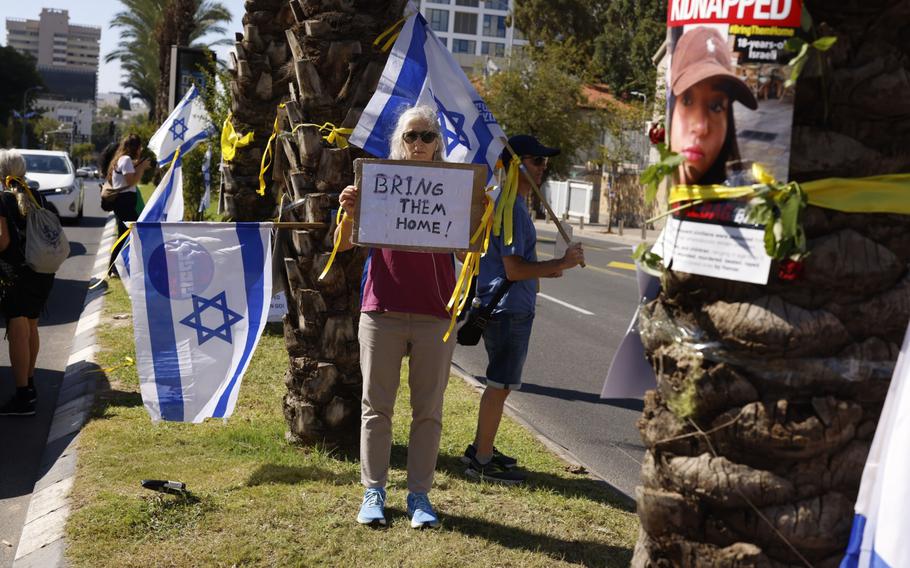
A protest demanding the release of Israelis kidnapped by Hamas militants outside the HaKirya military base in central Tel Aviv. (Kobi Wolf/Bloomberg)
Lying in a makeshift bed, her upper arm badly broken, her face in anguish, 21-year-old Mia Shem speaks to the camera. Held captive in Gaza, she says she wants to be reunited with her parents and siblings in Israel.
The video, released on Monday, is the first sign of life of about 200 hostages from some two dozen countries seized in Israel by Hamas operatives. They were taken when 1,300 other Israelis were killed in an assault 10 days ago that led to a punishing war in the Gaza Strip, which many fear will spread across the region.
The fate of kidnapped or captured Israelis has long held a special place in the national consciousness. Hundreds of prisoners have been released to bring back a single Israeli. Sometimes, prisoners have been freed only for the bodies of those fallen so they could be buried in their homeland.
But as the scores of civilian hostages languish across the Gaza Strip, besieged and bombed by the Israeli military as it seeks to destroy Hamas, their fate is being contemplated with a new mix of emotions.
Of course, Israel wants to bring them home. Within hours of the Oct. 7 attack, top military, legal and media experts formed the Hostages and Missing Families Forum with that specific goal. Many other countries are involved, negotiations have been launched for their release and everyone agrees the hostages are a top priority.
But there is a gnawing and growing sense in Israel that it must reconsider its longstanding policy, harden its heart and send a brutal message to its enemies.
“The situation now is different for two main reasons,” says Ariel Merari, a retired professor who focused on anti-terrorism and was part of an army negotiating team. “The first is that Israel is in a state of war. Most of the public — despite sympathizing with the hostages and their families — feel that now the war must be won. The second reason is that the public now understands better than ever the huge error that was made in the handling of past abductions.”
Put simply, Merari says, Israel has given away far too much — and paid a terrible price.
In 1985, for example, Israel released 1,151 prisoners and detainees to a Palestinian group for three Israeli soldiers captured in the 1982 Lebanon War. One of the prisoners released was Ahmed Yassin, who went on to form a new movement — Hamas — straight out of prison.
The last big prisoner swap was with Hamas in 2011 when 1,027 Palestinians were released for a single kidnapped solider — Gilad Shalit, who had been held in Gaza for five years. That was done by Prime Minister Benjamin Netanyahu, who was premier then as well.
One of the Palestinian prisoners released then was Yahya Sinwar, now Hamas’ top leader in Gaza. Israel says he’s responsible for initiating, planning and leading the Oct. 7 attacks. He is the top target as the Israeli military pounds the coastal enclave and prepares for an expected ground invasion. Six other prisoners released in 2011 went on to become senior Hamas leaders in Gaza and the West Bank.
“Such a record changes the public inclination to put hostage release first,” says Merari, the retired negotiator.
Hamas’s attack earlier this month was shocking not just for the sadism on display — heads chopped off, babies burned — but also because of its sophistication. Thousands of missiles were shot at Israel while more than 2,500 commandos took over military bases and civilian communities, killing freely.
Part of the unstated justification for previous lopsided deals was the sense that Israel was so much stronger than its enemies, it could handle a losing bargain to demonstrate care for its citizens, who give two to three years of their life to military service. They are owed the full force of the state to bring them home if they are taken.
Now that feeling has yielded to a sense of vulnerability and the belief that enemies need to see Israel as hardened enough to walk away.
“For decades, we have turned our captives and MIAs into a tool for blackmailing us,” wrote Nadav Haetzni, a lawyer and writer, in Yisrael Hayom newspaper on Monday. “We capitulated to the enemy and we ended up with far more people murdered and kidnapped. Worst of all, as has just now been proved to us once again, we risked our very existence.”
Israel said it confirmed that 199 Israelis had been kidnapped as of Monday night. Hamas, which is designated a terrorist organization by the US and European Union, says it has 200 hostages and that 50 others are being held by others.
The rules for hostage negotiation are in flux. In 2008, a public committee headed by a former Supreme Court justice set guidelines. One of its findings was the need to disconnect political leaders from families to avoid pressure or sentiment getting in the way of rational decision making.
Yet Netanyahu met with families earlier this week. Haetzni said this is an error repeatedly committed by Israeli leaders.
“We have been paying for the past 12 years for Benjamin Netanyahu’s capitulation to the campaign to release Gilad Shalit,” he wrote. “Dozens of Israelis were murdered as a result of actions taken by people who were released in that deal.” Haetzni added, “That capitulation stemmed from the leadership’s lack of backbone, but also from the folly and weakness of the elites, which enlisted to get the leaders to capitulate.”
In the end, he said, Israel needs to redefine the line that separates showing empathy and encouraging national weakness.